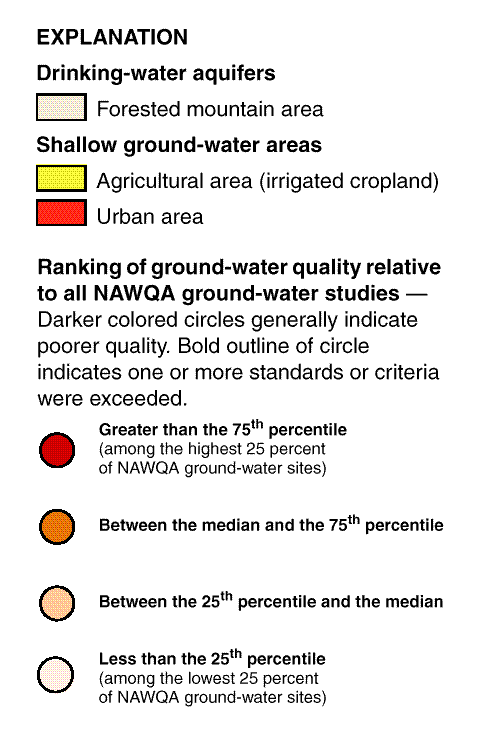RADON
|
|---|
|

(6,893 bytes)
|
Radon concentrations measured in wells completed in the crystalline bedrock of forested mountain areas and the alluvial aquifer in the Denver urban area were among the highest of all NAWQA ground-water sites nationwide. Wells completed in agricultural areas (alluvium) had comparatively low concentrations and were ranked below the national median (50thpercentile).
|
NITRATE
|
|---|
|

(8,914 bytes)
|
Nitrate concentrations in shallow ground water underlying irrigated agricultural lands were among the highest of all NAWQA ground-water sites, and water from about one-half the wells sampled exceeded drinking-water standards. Ground water sampled from wells in the forested mountain areas had nitrate concentrations that were below the national median. Only one well exceeded drinking-water standards in the mountain area. Ten percent of the samples collected from the shallow alluvial ground water in the urban area exceeded the USEPA drinking-water standard.
|
DISSOLVED SOLIDS
|
|---|
|

(9,357 bytes)
|
The median dissolved-solids concentrations in the urban and agricultural areas of the basin ranked in the top 25 percent of all NAWQA ground-water sites; no drinking-water wells were sampled in these areas. Although dissolved-solids concentrations in the mountain area were among the lowest for NAWQA sites, they exceeded drinking-water standards in 2 of the 27 household wells sampled.
|
|
VOLATILE ORGANIC COMPOUNDS
|
|---|
|
 (10,480 bytes) (10,480 bytes)
|
No VOCs were detected in ground water underlying agricultural areas. In contrast, more than 86 percent of urban wells sampled contained VOCs, placing it in the top 25 percent of all NAWQA ground-water sites nationwide. Only 30 percent of mountain wells sampled contained VOCs, but national NAWQA rankings were such that VOC detections in drinking-water wells sampled in the mountain areas of the basin were also among the highest for all NAWQA ground-water sites nationwide.
|
PESTICIDES
|
|---|

(9,776 bytes)
|
Pesticides were detected in greater than 90 percent of the wells sampled in urban and agricultural areas. Pesticides were detected in 27 of 30 wells sampled in the urban area and 29 of 30 wells sampled in the agricultural area, which ranks these areas among the highest of all NAWQA ground-water sites nationwide. No pesticides were detected in the mountain area.
|
